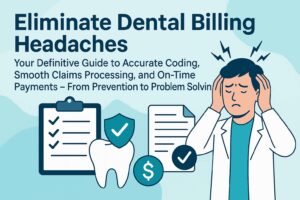
Understanding ADA Code 4346 and ADA Code 4910 in Dental Coding

In dental billing and coding, having a clear understanding of the various ADA codes is paramount for accurate documentation, efficient claim submission, and proper reimbursement. Two essential ADA codes to grasp in dental coding are ADA Code 4346 and ADA Code 4910. This article aims to provide a clear understanding of these codes, their applications, and their importance in dental coding.
ADA Code 4346: Scaling in the Presence of Moderate or Severe Gingival Inflammation
ADA Code 4346 represents the dental procedure known as scaling when there is moderate or severe inflammation of the gums. It is used when patients exhibit signs of gum disease, such as swollen and inflamed gums. Scaling involves the thorough removal of plaque, calculus (hardened plaque), and stains from both above and below the gumline. This procedure is crucial for effectively managing and treating gum disease.
Accurate coding with ADA Code 4346 is essential for proper reimbursement. Dentists must carefully document the presence and severity of gingival inflammation in the patient’s records, supporting the use of ADA Code 4346 during the billing process.
ADA Code 4910: Periodontal Maintenance
ADA Code 4910 relates to periodontal maintenance, which involves ongoing care and monitoring for patients with a history of periodontal disease. It is used when patients have previously undergone active periodontal treatment, such as periodontal scaling and root planing. Periodontal maintenance visits typically include plaque and calculus removal, site-specific scaling and root planing as needed, and comprehensive oral hygiene instructions.
Regular periodontal maintenance visits are crucial for maintaining the long-term success of periodontal treatment and effectively managing the patient’s periodontal health. ADA Code 4910 allows dentists to accurately document and bill for these essential maintenance visits.
Key Considerations for Dental Coding
When it comes to dental coding, there are some important factors to keep in mind:
- Documentation: Detailed and accurate clinical documentation is vital to support the use of specific ADA codes. Dentists should record the patient’s condition, the treatment provided, and any relevant findings in their records.
- Code Selection: Choosing the appropriate ADA code is crucial for accurate billing. Dentists should review the ADA code definitions and guidelines to determine the most suitable code based on the specific dental procedure performed.
- Insurance Guidelines: Staying up to date with insurance company guidelines is important. Insurance carriers may have specific requirements and limitations for certain procedures or code combinations, and dentists must ensure compliance with these guidelines.
In conclusion, ADA Code 4346 and ADA Code 4910 are significant in dental coding. Dentists should accurately document the presence of gingival inflammation and select the appropriate code to support efficient billing processes. Proper understanding and application of these codes contribute to effective dental practice management.
Discover the difference that OneDentalBilling.com can make for your dental practice today.
Check specific insurance company provider portals for coding and billing requirements relevant to your practice:
- American Dental Association (ADA): https://www.ada.org – The official website of the American Dental Association, providing comprehensive information on dental codes, guidelines, and resources.
- Centers for Medicare & Medicaid Services (CMS): https://www.cms.gov – The official website of CMS, offering valuable insights into Medicare and Medicaid billing guidelines and regulations.
- https://www.dentalcoding.com – A reputable online resource providing in-depth guidance on dental coding, including ADA codes and their applications.
- https://www.onedentalbilling.com – Discover how One Dental Billing can simplify your dental billing processes.
FAQs
Q1. What is the purpose of ADA Code 4346?
A1. ADA Code 4346 is used to represent scaling in the presence of moderate or severe gingival inflammation. This code is crucial for effectively managing gum disease by removing plaque, calculus, and stains from above and below the gumline.
Q2. How should dentists document the use of ADA Code 4346?
A2. Dentists should carefully document the presence and severity of gingival inflammation in the patient’s records. Detailed clinical notes regarding the condition of the gums support the use of ADA Code 4346 during the billing process.
Q3. What does ADA Code 4910 entail?
A3. ADA Code 4910 refers to periodontal maintenance, which involves ongoing care and monitoring for patients with a history of periodontal disease. It includes plaque and calculus removal, site-specific scaling and root planing as needed, and comprehensive oral hygiene instructions.
Q4. Are regular periodontal maintenance visits necessary after periodontal treatment?
A4. Yes, regular periodontal maintenance visits are crucial for maintaining the success of periodontal treatment. They help manage the patient’s periodontal health and ensure the long-term effectiveness of the treatment.
Q5. How can accurate dental coding benefit dental practices?
A5. Accurate dental coding ensures proper reimbursement for dental procedures and supports efficient claim submission. It also helps maintain clear and organized patient records and facilitates effective dental practice management.
Q6. Where can dentists find guidelines on dental coding?
A6. Dentists can refer to resources such as the American Dental Association (ADA) website and dental coding guides for comprehensive guidelines on dental coding. These resources offer valuable insights and support in selecting the appropriate ADA codes.
Q7. How can dentists stay updated with insurance company guidelines?
A7. Dentists should regularly review insurance company guidelines and updates, which are typically available on the insurers’ websites or through direct communication with insurance representatives. Staying informed helps ensure compliance with specific requirements and limitations.
Q8. How can dental billing services assist with accurate coding and claim submission?
A8. Dental billing services, such as OneDentalBilling.com, offer expertise in accurate coding and efficient claim submission. They can help dental practices navigate the complexities of dental coding, streamline the billing process, and maximize reimbursement.
Q9. Can dentists use ADA codes for both insurance claims and cash-based fee schedules?
A9. ADA codes, including ADA Code 4910, are commonly used for insurance claims. However, when patients pay out-of-pocket or utilize cash-based fee schedules, dentists may use alternative codes, such as ADA Code D4910, to indicate similar procedures.
Q10. How can dental professionals enhance practice efficiency through accurate coding?
A10. Accurate coding ensures precise documentation, efficient claim submission, and appropriate reimbursement. By maintaining accurate records and adhering to coding guidelines, dental professionals can optimize practice efficiency, streamline workflows, and support overall financial health.
These FAQs provide additional insights into the significance of ADA Code 4346 and ADA Code 4910, as well as other important considerations related to dental coding and billing practices.
Contact Us
Phone: 908-357-1515
111 Town Square Pl, Suite 1203 Jersey City, NJ 07310












